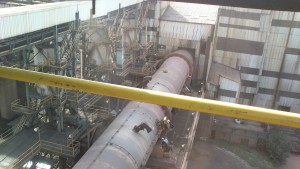
Rotary kiln:
Licenses:
Is the gun and ammunition approved for industrial use ?
The gun is approved by Pyrotechnische Bundesanstalt, Braunsweig (PTB) as a shooting tool and has received approval number 80, which is marked on the gun. The ammunition is approved by CIP, the European organization for control of ammunition. This control is continuous, and the ammunition is marked with approval stamp from the controlling proof house.
Can we get a license to buy a gun and ammunition ?
In all of Europe the authorities allow the use of Winchester’s gun and ammunition for industrial purposes, because the gun is a necessary tool, and no immediate abuse is possible. The gun weighs over 100 kilos and cannot be hand held when fired. The barrel is not riffled, but smooth as in a shotgun, therefore it is inaccurate on distances over 100 meters. The ammunition is caliber 8 gauge industrial, and cannot be used in any other weapon either civilian or military.
Where and how do we get the necessary licence ?
In some countries no license is required at all, e.g. Germany. Are you in doubt, you can contact your local police department, who can issue the necessary license for import, purchase, storage, use of the gun and the ammunition, or they can inform you of the prober authority where to apply.
These license can contain articles of how to store the ammunition in a locked depot separate from the gun, that the gun shall be secured with Winchester’s locking frame, when it is not in use. The license is issued to your company, and you can appoint the personnel who shall operate the gun.
Does it require special training to use the gun ?
We recommend, that only personnel who has been trained in the safety regulations use the gun, e.g. 2 persons from each shift. Do you not have the personnel who can train others, we can send a special factory trained representative who can help you work out safety instructions specific for your plant, and who can educate the shooters in efficient and safe use of the gun. When you purchase your first gun this training and education is free of charge.
Will the Safety Section and Union approve the use of an industrial gun in your factory ?
Safety Section and Union work for better and safer conditions for their workers. This is precisely what Winchester can offer. The advantage of using a Winchester industrial gun is reduced production down-time, because you can stand secure outside the kiln and remove balls or rings. Without the gun the kiln must be shutdown and the rings must be removed with pneumatic tools, this job is neither safe nor pleasant, so both Safety Section and Union will be positive to the new improved working conditions the gun will allow.
Shooting:
What can be shot at ? How many cartridges ? How long time ?
Rings:
The gun is designed to keep the Kiln clean, not to remove enormous rings which have almost closed the kiln. The foreman knows when a ring starts to build, even if he cannot see it, since it reduces the flow of air and ruins dispersion of heat in the kiln. As soon as these signs show, turn off the burner
and reduce the rotation speed.Within a short time the dust will have settled, and you can aim the gun and start to shoot. Under regular circumstances the ring will be shot down within 10-15 minutes and with 2-300 cartridges.
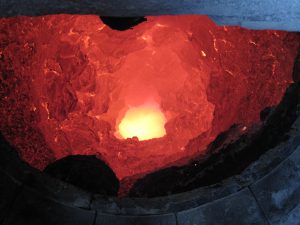 |
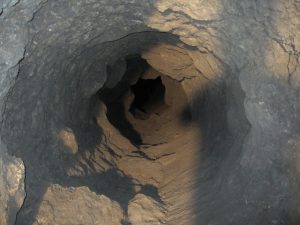 |
Balls:
Usually balls are easy to shoot with 10-15 cartridges. Also on balls the shooting should start as quickly as possible, not that big balls are difficult to shoot apart, but because big balls could damage the brick lining of the kiln.
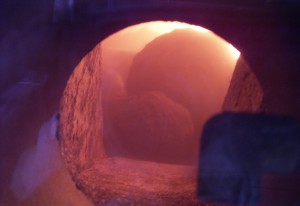 |
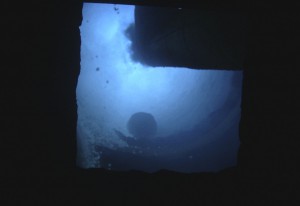 |
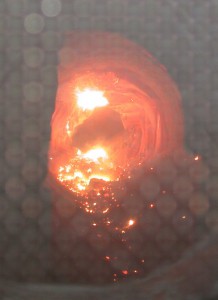 |
Here you can use the gun to shave rings down in size by shooting parallel with the kiln side continuously while the kiln rotates. This will keep the kiln in operation, but consumption of cartridges is vast up to 3.000 per a day.
Brick Lining:
It can be necessary to replace a worn brick lining e.g. in the burner zone. Here you can use the gun to shoot down the bricks while the kiln is cooling. This kind of shooting is different from shooting on rings and balls, because you shoot as perpendicular as possible on the kiln sides. This could imply a
risk for ricochets, the shooter must therefore be protected by a shield.
Can we shoot at ring 40 meters or more down the kiln ?
All visible rings can be shot away. Rings which are located so far in the kiln that you cannot see them, can also be removed with the gun, when shooting a long the side of the kiln while it is slowly rotating. The consumption of ammunition increases somewhat when you shoot invisible rings.
Is there any risk of damaging the brick lining, chains or equipment in the kiln?
Brick lining:
There is no risk of damaging the brick lining unless you intend to, as you shoot almost parallel with the sides of the kiln.
Chains:
After a longer period of shooting directly on the chains damages can occur. This will only happen if the gun is wrongly aimed, and you are shooting directly in the middle of the kiln instead of the sides where the rings are located.
Equipment:
If you have special equipment in your kiln, it could be damaged by ricochets. This equipment should be shielded next time you renovate the kiln, to secure it from damages.
Maintenance:
How long does the gun last ?
The gun is very rugged, and with a minimum of maintenance it can shoot up to 250.000 rounds. The maintenance of the gun is mainly to clean off cement and lime dust which wears very hard on the gun, and from time to time exchange the firing pin and some springs which wears during use. Our
instructor will teach you how to exchange these parts, and how you take the gun apart and clean the dust away.
Where do we get spare parts ?
With the gun you get a spare part catalog with the number of all parts.When you need a part you call, telefax or mail :
| Winchester Industrial Service V. Parbst & Søn Borsholmvej 41 DK-3000 Helsingør Denmark |
Phone: +45 49 76 54 00 Fax: +45 49 76 54 20 E-mail:WINCHESTER@PARBST.DK |
We have a complete stock of spare parts, and can ship the same day you order.
What do we do, when some day we no longer need the gun ?
You just contact us. For security purposes Winchester wants to buy back guns no longer in use. First of all to secure that the gun do not fall into the hands of ignorant persons, and secondly because an old worn-out gun suddenly can be taken into use again in your factory or somewhere else. The price paid for old guns is of course dependent upon it’s condition, but as minimum we usually pay USD 1.000,- per gun. If you want a more precis offer on your old gun, you can send it to us for evaluation.
Working conditions:
Is it hard/unpleasant to operate the gun ?
It is a routine job in a hot environments, as the shooter is located just in front of the kiln. The shooter and his assistance who loads the gun, should exchange jobs every half hour, and both should be relieved if the firing lasts for more than an hour.
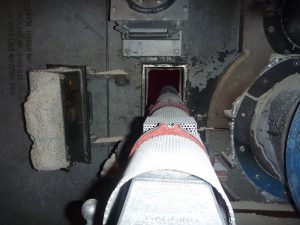 |
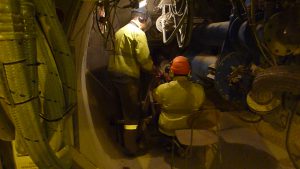 |
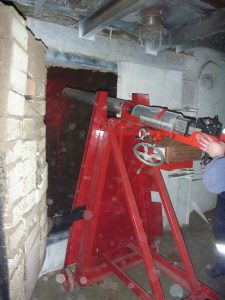 |
Does it make a lot of noise when the gun is fired ?
The Winchester industrial gun is equipped with a good silencer, (sound reducer), which absorbs most of the blast. The bullet, however, moves with supersonic speed, which causes a supersonic blast within the kiln. This blast cannot be reduced, therefore all persons on the burner deck during
shooting should wear earplugs. Outside the burner deck, even close to the kiln, the blast can only be vaguely heard, and there is no risk of hearing damage.
How do we aim the gun ?
As on regular guns there are fixed sights on top of the gun. The gun is adjusted with two handles. When the gun is roughly adjusted, the first shot is fired. There will come a red dot in the kiln where the shot has hit, and the shooter can now aim in relation to this red dot, through a whole in the
backplate, which allows you to aim directly through the barrel of the gun.
Shall the gun be aimed between rounds ?
The gun is very heavy almost 100 kilos and is therefore very steady when aimed and fired. After 4-5 rounds you should see if the ring you are shooting at is still there, and if the gun therefore should be re-aimed. If you need to continuously fire at the same spot, as when you want to trim several rings in
size, you can buy a tapping kit, which locks the gun in the wanted position (aiming direction).
How do we get the gun away from the hot kiln ?
Three men can easily lift the gun out of the trunion plate and down on the floor beside the kiln. Be careful not to damage the adjustment handles, loading handle and sound reducer when the gun is laid on the floor. Before the gun is taken down the Winchester locking frame should be installed. The gun is heaviest at the back and therefore you do not need to touch the hot sound reducer. When the gun has cooled down, it should be covered in order to protect it from dust.
Safety & Security:
Can an ricocheting bullet injure our staff or damage our equipment ?
If the gun is correctly mounted on the rotating kiln, with 10-40 centimeters of the sound reducer into the kiln, and you can only fire in a flat angel against the sides of the kiln, and ricochets will therefore go further on into the kiln. When removing bricks this is not the case, please read page 3 about the special security procedures for this operation.Also read page for protection of equipment in the kiln.
Are there any risks in connection with loading and firing the gun ?
The job as a shooter requires some safety equipment:
Earplugs, to avoid hearing damage after long lasting shooting
Safety glasses and vizier to protect face and eyes from hot powder gas from the gun and hot ashes, which can come out of the kiln when firing.
Gloves, as the gun can get very hot after intensive firing.
If the shooter use above mentioned safety equipment, as instructed, he will be protected from the harm and discomfort while firing.
Can the gun blow up by a mistake ?
From other types of guns chamber and barrel bursts are known, especially if the barrel is wholly or partly blocked. Due to the special circumstance that the Winchester gun has to operate under, it is impossible to prevent dust and ash from flying into the barrel. The gun is therefore built in such a way, that it can not burst, even if the barrel is totally blocked, the barrel will just enlarge. This will of course damage the gun, but there is no hazard to the shooter. To avoid damages on the gun, the barrel should regularly be blown clean with compressed air, and visually controlled after unusual incidents.
The chamber construction is so strong that it cannot blow up. If powder gas cannot get out, the upper edge of the cartridge will open up, and the hot gas will blow backwards. This gas is harmless and will be stopped by the vizier and the safety glasses which the shooter of course wears.
Can the gun or sound reducer be damaged by the heat ?
The gun will of course become very hot, partly because of the fired cartridges and partly because of the heat from the kiln. The sound reducer has a double function, it reduces the blast and also protects the gun from the heat of the kiln. The gun is therefore not damaged by the heat, and the sound reducer can stand the heat, even when it glows red. You do not have to stop firing to cool the gun, but can continue until the work is done. The shooter has to wear gloves, in order not to burn himself on the hot gun.
Can the cartridges endure to be close to the hot kiln, is there any risk for spontaneous ignition in the chamber due to the hot temperature of the gun ?
Gunpowder ignites at 148 degrees Celsius, which is far above the temperature in front of the kiln on the burner deck. The temperature in the chamber can exceed 148 degrees Celsius, but as the powder is protected by the shell and the 3 oz heavy lead bullet, the cartridge should be substantial time in
the chamber in order to spontaneously ignite, and the gun will have cooled down in the meantime, therefore spontaneous ignition will never happen.
As a safety measure: do not load any round into the chamber before the shooter is ready to fire, and the gun shall be unloaded immediately if firing does not take place.
This is to prevent accidents. The gun should never be left with a cartridge in the chamber when moved from one kiln to another, or when covered up.
What if someone steals our ammunition ?
Winchester caliber 8 gauge industrial cartridges do not fit in any other weapon either civilian or military.
The thief must also steal the gun in order to have use of the cartridges.With a weight of over 100 kilos the gun is neither very transportable nor usable for other purposes.


 Deutsch
Deutsch Français
Français Norsk
Norsk Русский
Русский